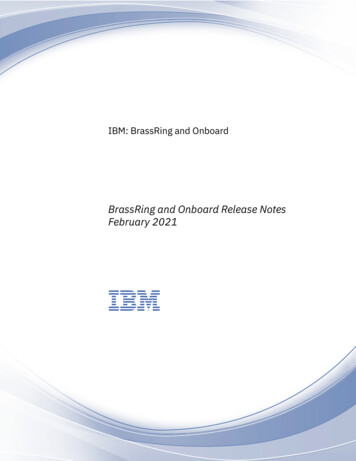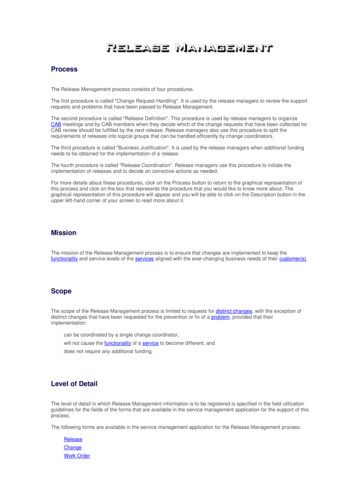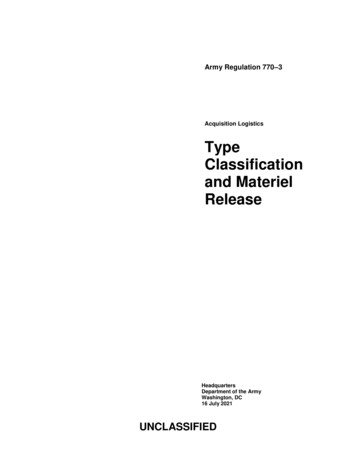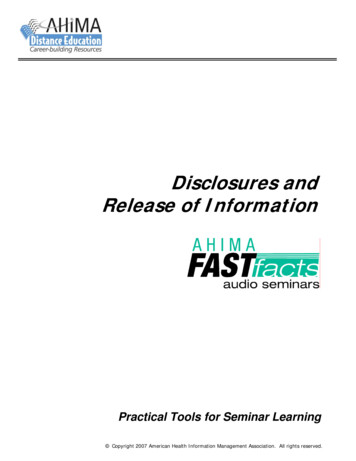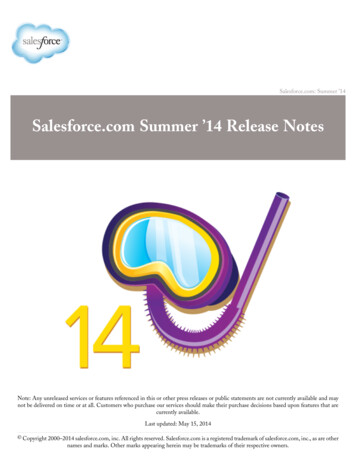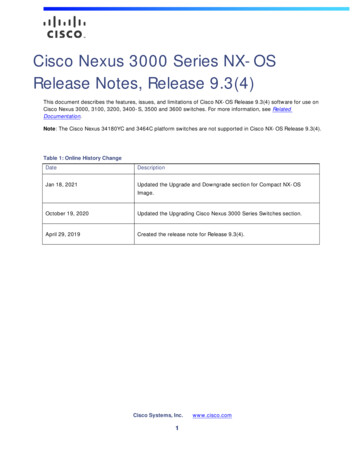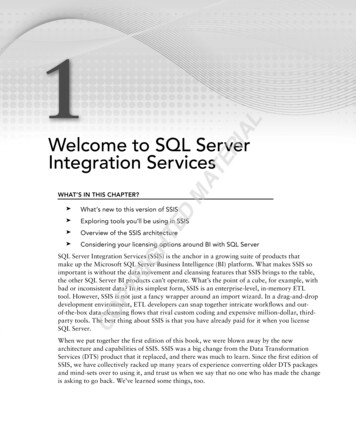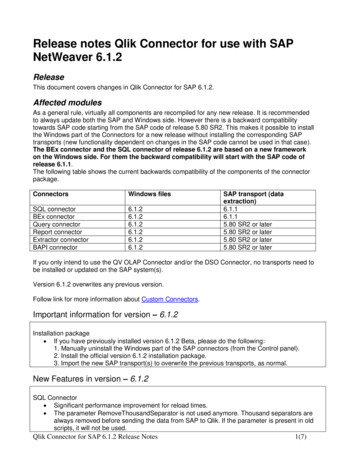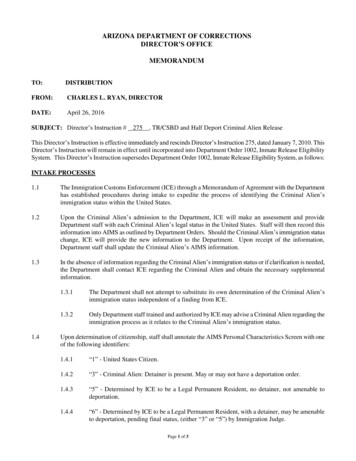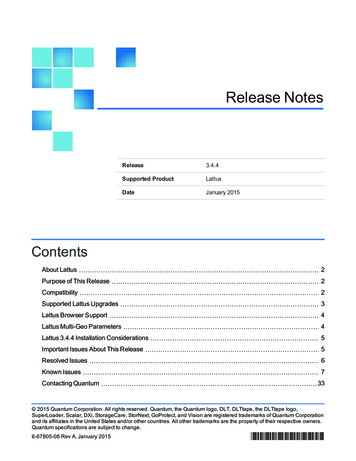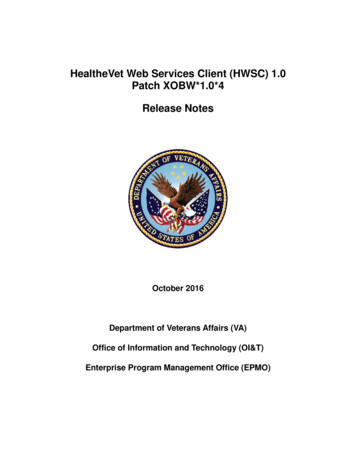
Transcription
HealtheVet Web Services Client (HWSC) 1.0Patch XOBW*1.0*4Release NotesOctober 2016Department of Veterans Affairs (VA)Office of Information and Technology (OI&T)Enterprise Program Management Office (EPMO)
Revision 20161.0HealtheVet Web Services Client (HWSC), PatchXOBW*1.0*4 initial Release Notes document:HealtheVet WebServices Client(HWSC) ProjectTeam Installs a Caché SSL/TLS Configurationnamed “encrypt only.”Disables the flag that prevents theconfiguration and execution of TLS/SSLenabled HWSC web service clients,specifically for OpenVMS.Disables verification of the remote server'shost name. This is something that is enabledby default in Web browsers where a user isinteracting with a browser; however, HWSC isa web service client with no user interaction.Also, RFC 2818 allows for disabling thisverification when "the client has externalinformation as to the expected identity of theserver" to which HWSC applications can beconfigured to use.HealtheVet Web Services Client (HWSC) 1.0 Patch XOBW*1.0*4Release NotesiiOctober 2016
Table of Contents1234Introduction . 1Purpose . 1Audience. 1HealtheVet Web Services Client Patch XOBW*1.0*4 . 14.14.24.34.45New Features and Functions . 1Enhancements and Modifications to Existing . 1Known Issues . 1Patch Numbering Scheme . 2Product Documentation . 2HealtheVet Web Services Client (HWSC) 1.0 Patch XOBW*1.0*4Release NotesiiiOctober 2016
1 IntroductionHealtheVet Web Services Client (HWSC) Patch XOBW*1.0*4 enables the use of Transport LayerSecurity/Secure Socket Layer (TLS/SSL) on OpenVMS systems.2 PurposeThese release notes cover the changes to the HealtheVet Web Services Client (HWSC) project with patchXOBW*1.0*4.3 AudienceThe audience for this document is Veterans Health Information Systems and Technology Architecture(VistA) application developers and Caché System Administrators.4 HealtheVet Web Services Client Patch XOBW*1.0*4Previous to this release, HWSC VistA applications were enabled to use Secure Socket Layer/TransportLayer Security (SSL/TLS) configurations to encrypt the connections; however, this worked on Linuxsystems, only. This feature was disabled in VistA applications on OpenVMS due to a problem with usingSSL/TLS on OpenVMS systems. This is no longer the case. Thus, this feature has been enabledconsistently on all VistA systems for both Linux and OpenVMS.4.1 New Features and FunctionsHWSC VistA applications can now enable SSL/TLS encryption to work in VistA applications onOpenVMS by referencing the “encrypt only” SSL/TLS configuration or any new customized SSL/TLSconfigurations.4.2 Enhancements and Modifications to ExistingPatch XOBW*1.0*4 makes the following enhancements to HWSC: Installs a Caché SSL/TLS Configuration named “encrypt only” using SSL Version 3. Disables the flag that prevents the configuration and execution of TLS/SSL enabled HWSC Webservice clients, specifically for OpenVMS. Disables verification of the remote server's host name. This is something that is enabled bydefault in Web browsers in which a user is interacting with a browser; however, HWSC is a Webservice client with no user interaction. Also, RFC 2818 allows for disabling this verification when"the client has external information as to the expected identity of the server," which HWSCapplications can be configured to use.4.3 Known Issues The TLS/SSL configuration must be installed in all nodes of a VistA system, both front-endserver nodes and database server nodes, as described in the HealtheVet Web Services Client(HWSC) 1.0 Patch XOBW*1.0*4 Installation, Back-Out, and Rollback Guide. The SSL/TLS configuration uses SSL version 3. The first application making use of SSL/TLS inHWSC is Master Patient Index (MPI), and the application needed to use SSL v 3 in order toconnect to their PSIM remote server. In the future, all VA systems will be mandated to upgrade tohigher versions of TLS and disable the use of older versions of SSL. When that happens, either anew XOBW patch will be issued to instruct system administrators to upgrade the SSL/TLSHealtheVet Web Services Client (HWSC) 1.0 Patch XOBW*1.0*4Release Notes1October 2016
configuration to a higher version of TLS, or control of these configurations will be given to theSystem Administrators’ group, Health Systems Platform, so that they can do the SSL/TLSconfiguration upgrades directly.We expect that any future changes to the SSL/TLS configuration will be coordinated with all theVistA application teams using SSL/TLS configurations, including HWSC-based applications andany other VistA applications that will have to use SSL/TLS encryption like HL7 applications.The coordination is important, so that the proper testing can be performed before the changes aremade to the production systems. This is the first use of SSL/TLS security, and the first application that used it, MPI, used theSOAP messaging features of HWSC. The SSL/TLS security should work the same withapplications using REST-based features as both styles use the same underlying securityfunctionality of SSL/TLS. We expect that future applications using REST and SSL/TLS securitywill do the appropriate testing before they release their application. Also, another security feature that was not used in this release with MPI is the use of CertificateAuthentication. We expect that future applications using Certificate Authentication will do theappropriate testing before they release their application.4.4 Patch Numbering SchemeThere is an inconsistency in the numbering scheme used to describe this patch and should be noted. Thispatch contains changes to both M routines and Caché ObjectScript classes. The M routines correctly use the traditional patch numbering system on the second line as:;;1.0;HwscWebServiceClient;**4**;September 13, 2010;Build 9Where the current version number is 1.0, the patch number is 4, and the build number is 9. The two Caché ObjectScript classes incorrectly use the following scheme in the class commentas:// HealtheVet Web Service Client v1 [Build: 1.0.1.009]Where “Build: 1.0.1.009” is interpreted as version 1.0, patch 1, and build 9. The number shouldcorrectly have been “Build: 1.0.4.009”.The most important number to consider is the current version, 1.0, which is correctly displayed in boththe routines and the classes.This patch numbering discrepancy will not break any functionality or affect any applications using thissoftware.5 Product DocumentationThe following documents describe the new functionality introduced with this release: HealtheVet Web Services Client (HWSC) 1.0 Patch XOBW*1.0*4 Installation, Back-Out,and Rollback GuideHealtheVet Web Services Client (HWSC): Patch XOBW*1.0*4 Security ConfigurationGuideHealtheVet Web Services Client (HWSC) user documentation can also be found on the VA SoftwareDocument Library (VDL) at: http://www.va.gov/vdl/application.asp?appid 180HealtheVet Web Services Client (HWSC) 1.0 Patch XOBW*1.0*4Release Notes2October 2016
HealtheVet Web Services Client (HWSC), Patch XOBW*1.0*4 initial Release Notes document: Installs a Caché SSL/TLS Configuration named "encrypt_only." Disables the flag that prevents the configuration and execution of TLS/SSL enabled HWSC web service clients, specifically for OpenVMS. Disables verification of the remote server's
